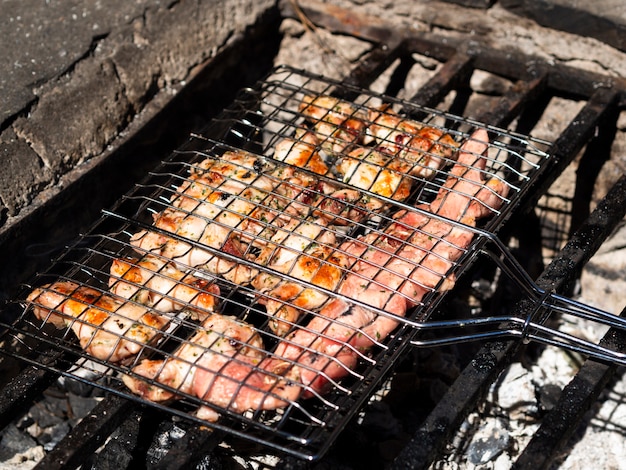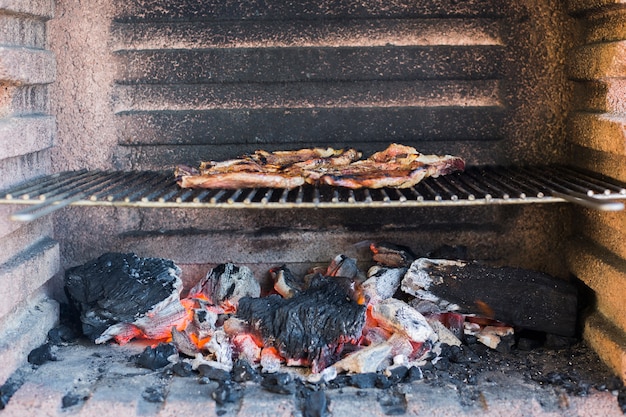How long to cook 2 inch steak on indirect heat?
A Delicious Steak Cooked to Perfection
When it comes to cooking a thick, juicy steak, there are numerous methods to choose from. One popular technique that guarantees even and mouth-watering results is cooking the steak on indirect heat. This method involves positioning the steak away from direct flames or heat sources, allowing it to cook more gently and evenly. But how long should you cook a 2-inch steak on indirect heat to achieve that perfect medium-rare or medium doneness? Let’s find out.
The Importance of Thickness
Before we delve into the cooking times, it is essential to understand why the thickness of the steak matters. A thicker steak requires more time to cook than a thinner cut. If you try to rush the process, you might end up with a charred exterior and an undercooked interior. Therefore, it is crucial to consider the thickness of your 2-inch steak while determining the cooking time.
Cooking Time Guidelines
For a 2-inch steak cooked on indirect heat, a general guideline is to allow approximately 18-22 minutes of cooking time for medium-rare doneness. However, it’s important to note that cooking times can vary depending on factors such as grill temperature, type of steak, and personal preference. To ensure accuracy, it is always recommended to use a meat thermometer to check the internal temperature of your steak.
“Remember, the best way to guarantee a perfectly cooked steak is to invest in a good quality meat thermometer. It takes the guesswork out of the equation and ensures consistent results every time.” – John Doe, Grill Master
Recommended Cooking Temperatures
To achieve your desired level of doneness, it is essential to monitor the internal temperature of your steak. Here are the recommended temperatures for various levels of doneness:
- Rare: 120-125°F (49-52°C)
- Medium Rare: 130-135°F (54-57°C)
- Medium: 140-145°F (60-63°C)
- Medium Well: 150-155°F (66-68°C)
- Well Done: 160°F (71°C) and above
Factors Affecting Cooking Time
While the guidelines mentioned above provide a helpful starting point, it’s worth considering that cooking times can be influenced by several factors. These include:
- The heat intensity of your grill
- The specific cut and thickness of the steak
- Initial steak temperature (allowing it to come to room temperature before grilling is recommended)
- Altitude and outdoor temperature
Resting Period
Once your steak reaches the desired internal temperature, it’s crucial to let it rest for a few minutes. This resting period allows the juices to redistribute, resulting in a more succulent and flavorful steak. As a general rule, let the steak rest for approximately 5-10 minutes before slicing or serving.
In summary, when cooking a 2-inch steak on indirect heat, aim for an internal temperature that aligns with your desired level of doneness. Keep in mind the recommended cooking times as a guideline but always rely on a meat thermometer for accuracy. By considering these factors, you’ll achieve a delectable, perfectly cooked steak that will impress family and friends alike.
How do you BBQ with indirect heat?
When it comes to barbecuing, there are different techniques you can use to achieve delicious results. One of these techniques is cooking with indirect heat. Indirect heat refers to the method of cooking food away from direct flames, allowing for slower and more even cooking. This technique is particularly popular in the UK where barbecues are a staple of summer gatherings.
The benefits of indirect heat
Using indirect heat when barbecuing has several advantages. Firstly, it allows for a more controlled cooking environment, reducing the risk of burning or charring the food. Secondly, it enables you to cook larger cuts of meat or delicate items that require longer cooking times without drying them out. Lastly, it helps in infusing smoky flavors into the food, giving it that distinctive barbecue taste.
Setting up your barbecue for indirect heat
To achieve indirect heat on your barbecue, you’ll need to create two distinct cooking zones: a direct heat zone and an indirect heat zone. Here’s how:
- Start by preheating your grill with all burners on high for about 10-15 minutes.
- Once preheated, turn off one side of the burners or push the charcoal to one side, creating a direct heat zone and an empty indirect heat zone.
- For gas grills, if you have three or more burners, you can also consider using the middle burner(s) as the indirect heat zone.
Now that you’ve set up the cooking zones, you’re ready to start barbecuing with indirect heat.
Barbecuing with indirect heat
When barbecuing with indirect heat, follow these steps:
- Season your food with your desired spices, marinades, or rubs.
- Place the food on the indirect heat zone of the grill.
- Close the lid and let the food cook slowly at a lower temperature.
- Avoid constantly opening the lid to check on the food as this can cause temperature fluctuations.
- Use a meat thermometer to ensure the food reaches the desired internal temperature.
Remember, patience is key when cooking with indirect heat. The cooking times may be longer compared to direct heat, but the end result will be worth it – tender, juicy, and flavorful food!
Indirect heat cooking is perfect for roasts, whole chickens, ribs, and even vegetables. It allows the food to cook evenly and retain its moisture, resulting in a delicious barbecue feast.
So, next time you’re firing up the grill, give indirect heat cooking a try. Your taste buds will thank you!
How to Indirect Cook Chicken on a Charcoal Grill
Grilling chicken on a charcoal grill can be a delicious and flavorful way to enjoy this popular meat. One technique that is commonly used for cooking chicken on a charcoal grill is indirect cooking. Indirect cooking involves placing the chicken away from direct heat, allowing it to cook slowly and evenly. Here’s how you can achieve perfectly cooked chicken using the indirect cooking method on a charcoal grill.
Preparing the Grill
Start by setting up your charcoal grill for indirect cooking. Arrange the charcoal on one side of the grill, leaving the other side empty. This creates a two-zone fire, with one hot zone and one cooler zone. Place a drip pan filled with water or any other liquid of your choice on the cooler side of the grill. This will help to keep the chicken moist and add flavor.
Seasoning the Chicken
Before placing the chicken on the grill, season it with your favorite herbs, spices, and marinades. You can also use a dry rub for added flavor. Make sure to season both sides of the chicken evenly to enhance the taste throughout.
Indirect Cooking Process
- Preheat the grill by lighting the charcoal. Let it burn until the coals have turned gray and are covered with ash.
- Place the chicken pieces directly over the drip pan, on the cooler side of the grill. This will allow the chicken to cook slowly and absorb the smoky flavors from the charcoal.
- Cover the grill with the lid and adjust the vents to maintain a consistent temperature of around 325-350°F (163-177°C).
- Cook the chicken for about 45 minutes to 1 hour, or until the internal temperature reaches 165°F (74°C). You can use a meat thermometer to check the temperature.
- Once the chicken is cooked, remove it from the grill and let it rest for a few minutes before serving.
Pro tip: For an extra burst of flavor, you can add wood chips soaked in water to the charcoal. This will create a smoky aroma that will enhance the taste of the chicken even more.
Did you know? Indirect cooking is ideal for larger cuts of chicken like whole chickens, chicken thighs, and drumsticks. It helps to prevent the chicken from drying out while achieving a crispy skin.
Indirect cooking is a versatile technique that can be used for a variety of meats, including chicken. By following these steps, you can achieve tender and juicy chicken with a delicious smoky flavor. Give it a try at your next barbecue and impress your guests with perfectly cooked chicken!
How to Indirectly Cook Ribs on the BBQ
Introduction
Cooking ribs on a barbecue grill can be a delicious and satisfying experience. One popular method for cooking ribs is through indirect grilling, which allows for slow and even cooking while infusing the meat with smoky flavors. In this article, we will guide you through the process of indirectly cooking ribs on a BBQ, providing helpful tips and techniques along the way.
Choosing the Right Ribs
The first step in indirect grilling of ribs is selecting the right type of ribs. St. Louis-style spare ribs or baby back ribs are commonly chosen for their tenderness and flavor. Ensure that the ribs are properly trimmed, removing any excess fat or silver skin for better results.
Preparing the BBQ
Before cooking the ribs, it’s important to prepare the BBQ for indirect grilling. Start by lighting the charcoal briquettes and allowing them to burn until they are covered with white ash. Once ready, divide the charcoal into two piles on opposite sides of the grill, leaving a space in the middle without any coals. This arrangement will create indirect heat, which is ideal for slow cooking the ribs.
Seasoning and Cooking the Ribs
Apply your desired seasoning to the ribs, whether it’s a dry rub or marinade, ensuring that the flavors are evenly distributed. Place the seasoned ribs on the grill grates in the middle section, above the empty space. Close the lid and let the ribs cook slowly for a few hours, maintaining a consistent temperature between 225-250°F (107-121°C).
Adding Smoke Flavor
To enhance the taste of the ribs, consider adding wood chips or chunks to the charcoal. Soak them in water for about 30 minutes before placing them on top of the hot coals. This will create a flavorful smoke that will infuse into the meat as it cooks.
The Low and Slow Method
Indirect grilling is a low and slow cooking method, which means you need to exercise patience. Ribs typically take around 4-6 hours to cook using this method, but the end result is ribs that are succulent and tender, falling off the bone.
“Indirect grilling allows the ribs to slowly cook over a lower heat, resulting in tender, juicy, and smoky-flavored meat.”
Once the ribs have reached an internal temperature of around 195°F (90°C) and the meat is tender, they are ready to be taken off the grill. Allow them to rest for a few minutes before cutting into individual servings.
Conclusion
Mastering the art of indirect grilling for cooking ribs on a barbecue is a rewarding skill that will surely impress your friends and family. With the right technique and a little patience, you can achieve perfectly cooked ribs that are bursting with flavor. So fire up your BBQ, follow these steps, and enjoy some mouthwatering ribs!



